stop start RENAULT ESPACE 2012 J81 / 4.G Owner's Manual
[x] Cancel search | Manufacturer: RENAULT, Model Year: 2012, Model line: ESPACE, Model: RENAULT ESPACE 2012 J81 / 4.GPages: 267, PDF Size: 8.95 MB
Page 143 of 267
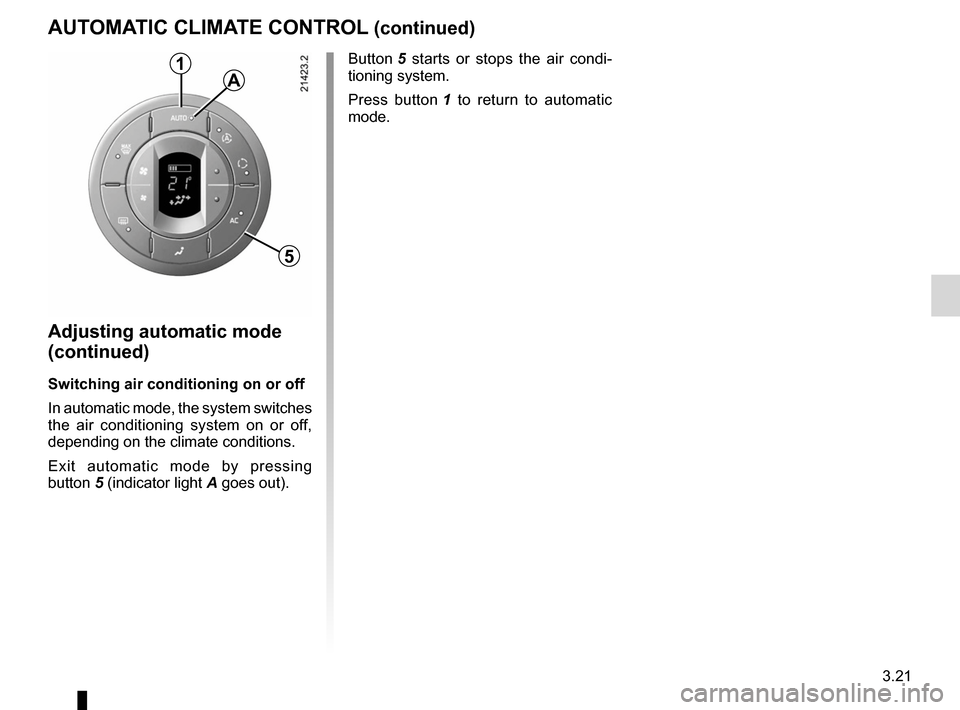
JauneNoirNoir texte
3.21
ENG_UD20382_1
Air conditionné automatique (X81 - J81 - Renault)
ENG_NU_932-3_X81ph3_Renault_3
AUTOMATIC CLIMATE CONTROL (continued)
Adjusting automatic mode
(continued)
Switching air conditioning on or off
In automatic mode, the system switches
the air conditioning system on or off,
depending on the climate conditions.
Exit automatic mode by pressing
button 5 (indicator light A goes out).
Button 5 starts or stops the air condi -
tioning system.
Press button 1 to return to automatic
mode.1A
5
Page 154 of 267
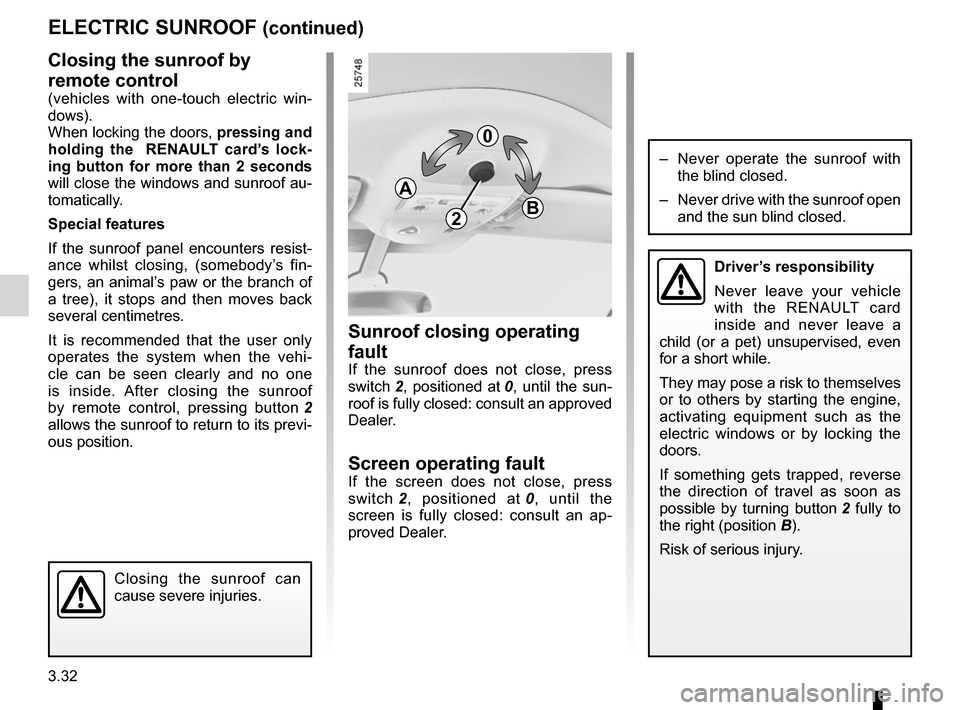
children .................................................................. (current page)
child safety ............................................................. (current page)
3.32
ENG_UD20387_1
Toit ouvrant électrique (X81 - J81 - Renault)
ENG_NU_932-3_X81ph3_Renault_3
ELECTRIC SUNROOF (continued)
Closing the sunroof by
remote control
(vehicles with one-touch electric win -
dows).
When locking the doors, pressing and
holding the RENAULT card’s lock -
ing button for more than 2 seconds
will close the windows and sunroof au-
tomatically.
Special features
If the sunroof panel encounters resist -
ance whilst closing, (somebody’s fin -
gers, an animal’s paw or the branch of
a tree), it stops and then moves back
several centimetres.
It is recommended that the user only
operates the system when the vehi -
cle can be seen clearly and no one
is inside. After closing the sunroof
by remote control, pressing button 2
allows the sunroof to return to its previ-
ous position.
Closing the sunroof can
cause severe injuries.
Sunroof closing operating
fault
If the sunroof does not close, press
switch 2, positioned at 0, until the sun-
roof is fully closed: consult an approved
Dealer.
Screen operating faultIf the screen does not close, press
switch 2 , positioned at 0 , until the
screen is fully closed: consult an ap -
proved Dealer.
Driver’s responsibility
Never leave your vehicle
with the RENAULT card
inside and never leave a
child (or a pet) unsupervised, even
for a short while.
They may pose a risk to themselves
or to others by starting the engine,
activating equipment such as the
electric windows or by locking the
doors.
If something gets trapped, reverse
the direction of travel as soon as
possible by turning button 2 fully to
the right (position B).
Risk of serious injury.
– Never operate the sunroof with
the blind closed.
– Never drive with the sunroof open
and the sun blind closed.
2
A
0
B
Page 206 of 267
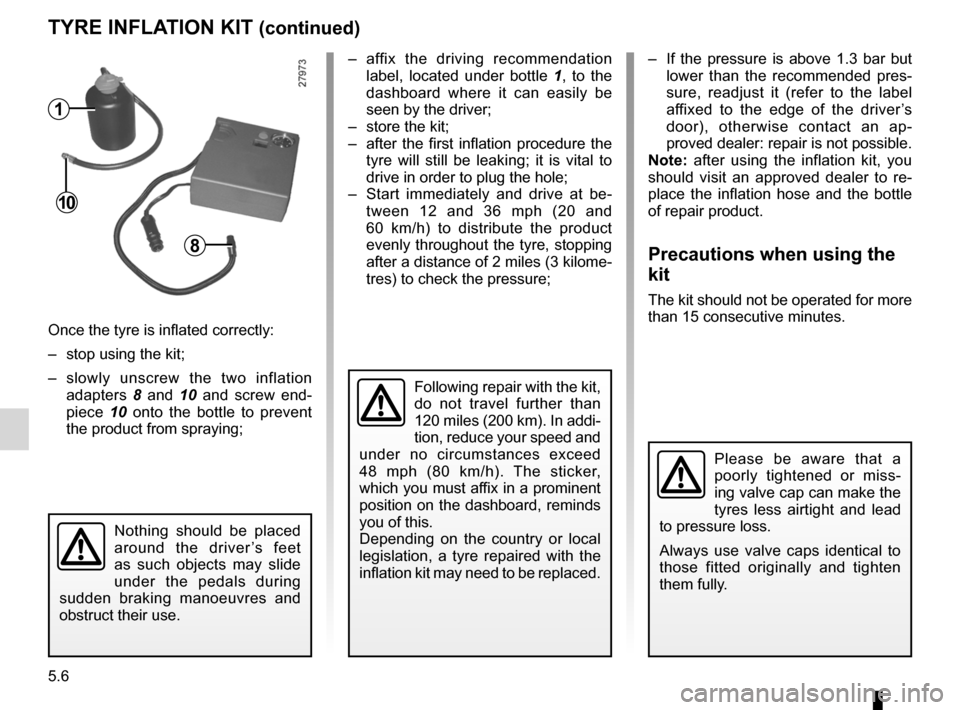
5.6
ENG_UD24347_2
Add J81 kit de gonflage (X81 - J81 - Renault)
ENG_NU_932-3_X81ph3_Renault_5
tYre InFLA tIOn KIt (continued)
Once the tyre is inflated correctly:
– stop using the kit;
– slowly unscrew the two inflation
adapters 8 and 10 and screw end -
piece 10 onto the bottle to prevent
the product from spraying;
– affix the driving recommendation
label, located under bottle 1 , to the
dashboard where it can easily be
seen by the driver;
– store the kit;
– after the first inflation procedure the
tyre will still be leaking; it is vital to
drive in order to plug the hole;
– Start immediately and drive at be -
tween 12 and 36 mph (20 and
60 km/h) to distribute the product
evenly throughout the tyre, stopping
after a distance of 2 miles (3 kilome-
tres) to check the pressure; –
If the pressure is above 1.3 bar but
lower than the recommended pres -
sure, readjust it (refer to the label
affixed to the edge of the driver ’s
door), otherwise contact an ap -
proved dealer: repair is not possible.
n ote: after using the inflation kit, you
should visit an approved dealer to re -
place the inflation hose and the bottle
of repair product.
Precautions when using the
kit
The kit should not be operated for more
than 15 consecutive minutes.
Following repair with the kit,
do not travel further than
120 miles (200 km). In addi -
tion, reduce your speed and
under no circumstances exceed
48 mph (80 km/h). The sticker,
which you must affix in a prominent
position on the dashboard, reminds
you of this.
Depending on the country or local
legislation, a tyre repaired with the
inflation kit may need to be replaced.
Nothing should be placed
around the driver ’s feet
as such objects may slide
under the pedals during
sudden braking manoeuvres and
obstruct their use.
Please be aware that a
poorly tightened or miss -
ing valve cap can make the
tyres less airtight and lead
to pressure loss.
Always use valve caps identical to
those fitted originally and tighten
them fully.
1
8
10
Page 230 of 267
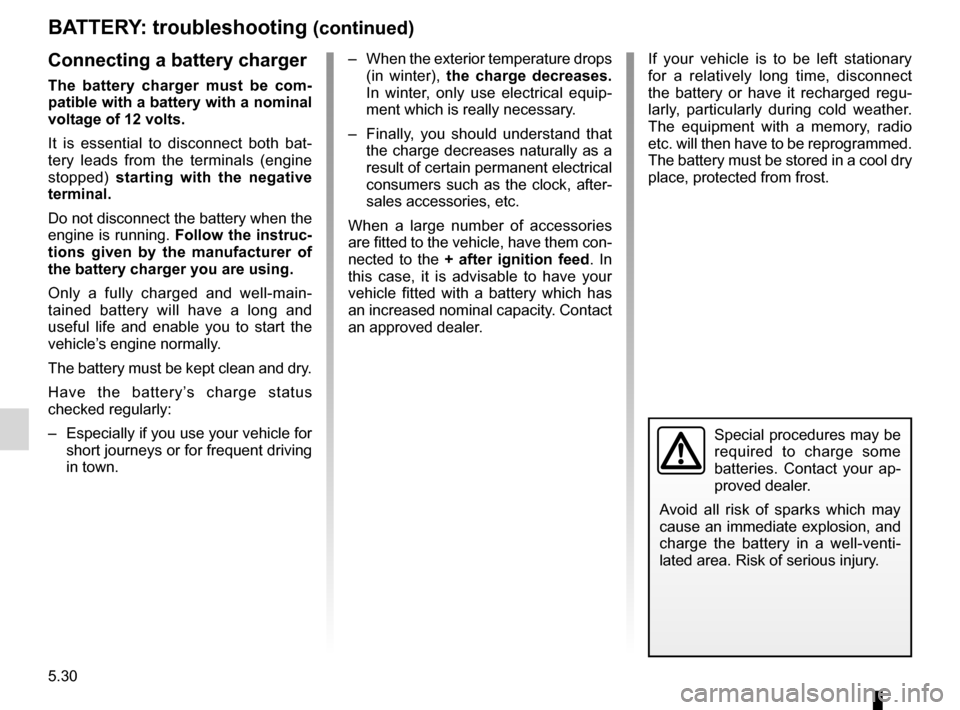
5.30
ENG_UD20429_1
Batterie : dépannage (X81 - J81 - Renault)
ENG_NU_932-3_X81ph3_Renault_5
Jaune NoirNoir texte
BAtter Y: troubleshooting (continued)
connecting a battery charger
t he battery charger must be com -
patible with a battery with a nominal
voltage of 12 volts.
It is essential to disconnect both bat -
tery leads from the terminals (engine
stopped) starting with the negative
terminal.
Do not disconnect the battery when the
engine is running. Follow the instruc-
tions given by the manufacturer of
the battery charger you are using.
Only a fully charged and well-main -
tained battery will have a long and
useful life and enable you to start the
vehicle’s engine normally.
The battery must be kept clean and dry.
Have the battery’s charge status
checked regularly:
– Especially if you use your vehicle for
short journeys or for frequent driving
in town. –
When the exterior temperature drops
(in winter), the charge decreases.
In winter, only use electrical equip -
ment which is really necessary.
– Finally, you should understand that
the charge decreases naturally as a
result of certain permanent electrical
consumers such as the clock, after-
sales accessories, etc.
When a large number of accessories
are fitted to the vehicle, have them con-
nected to the + after ignition feed. In
this case, it is advisable to have your
vehicle fitted with a battery which has
an increased nominal capacity. Contact
an approved dealer. If your vehicle is to be left stationary
for a relatively long time, disconnect
the battery or have it recharged regu
-
larly, particularly during cold weather.
The equipment with a memory, radio
etc. will then have to be reprogrammed.
The battery must be stored in a cool dry
place, protected from frost.
Special procedures may be
required to charge some
batteries. Contact your ap -
proved dealer.
Avoid all risk of sparks which may
cause an immediate explosion, and
charge the battery in a well-venti -
lated area. Risk of serious injury.
Page 237 of 267
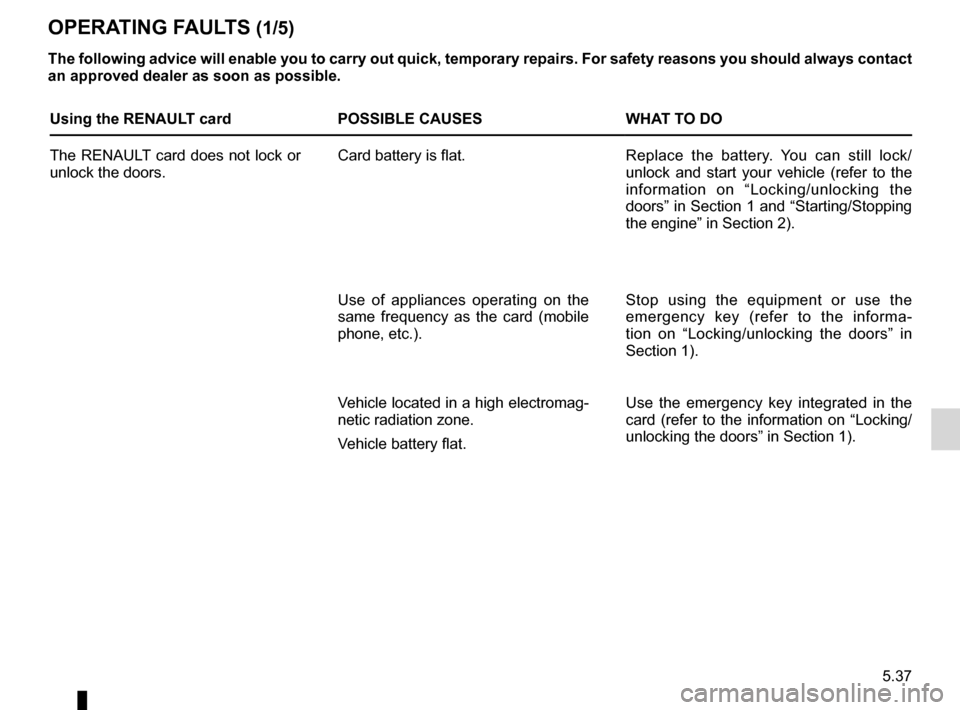
operating faults ..................................... (up to the end of the DU)
faults operating faults ............................... (up to the end of the DU)
5.37
ENG_UD22228_7
Anomalies de fonctionnement (J81 - X84 - B84 - C84 - L84 - K84 - J84 - \
R84 - X91 - B91 - K91 - Renault)
ENG_NU_932-3_X81ph3_Renault_5
Operating faults
OPerA tInG FAuL tS (1/5)
the following advice will enable you to carry out quick, temporary repairs. For safety reasons you should always contact
an approved dealer as soon as possible.
using the renAuL t card POSSIBLe cAuSeS WHAt tO DO
The RENAULT card does not lock or
unlock the doors. Card battery is flat.
Replace the battery. You can still lock/
unlock and start your vehicle (refer to the
information on “Locking/unlocking the
doors” in Section 1 and “Starting/Stopping
the engine” in Section 2).
Use of appliances operating on the
same frequency as the card (mobile
phone, etc.). Stop using the equipment or use the
emergency key (refer to the informa
-
tion on “Locking/unlocking the doors” in
Section 1).
Vehicle located in a high electromag -
netic radiation zone.
Vehicle battery flat. Use the emergency key integrated in the
card (refer to the information on “Locking/
unlocking the doors” in Section 1).
Page 238 of 267

5.38
ENG_UD22228_7
Anomalies de fonctionnement (J81 - X84 - B84 - C84 - L84 - K84 - J84 - \
R84 - X91 - B91 - K91 - Renault)
ENG_NU_932-3_X81ph3_Renault_5
Jaune NoirNoir texte
OPerA tInG FAuL tS (2/5)
the starter is activated POSSIBLe cAuSeSWHAt tO DO
The instrument panel indicator lights
are weak or fail to light up and the
starter does not turn. Battery terminals not tight, battery
terminals disconnected or oxidised.
Retighten or reconnect the terminals, or
clean them if they are oxidised.
Discharged battery or not opera -
tional. Connect another battery to the faulty bat
-
tery. Refer to information on “Battery: trou-
bleshooting” in Section 5 or replace the bat-
tery if necessary.
Do not push the vehicle if the steering
column is locked.
The engine will not start. Starting conditions are not fulfilled.Refer to the information on “Starting/stop -
ping the engine” in Section 2.
The hands-free RENAULT card
does not work. Insert the card in the card reader in order to
start the engine.
Refer to the information on “Starting/stop
-
ping the engine” in Section 2.
The engine cannot be switched off. Card not detected.Insert the card in card reader.
Electronic fault. Press the starter button quickly five times.
Page 262 of 267
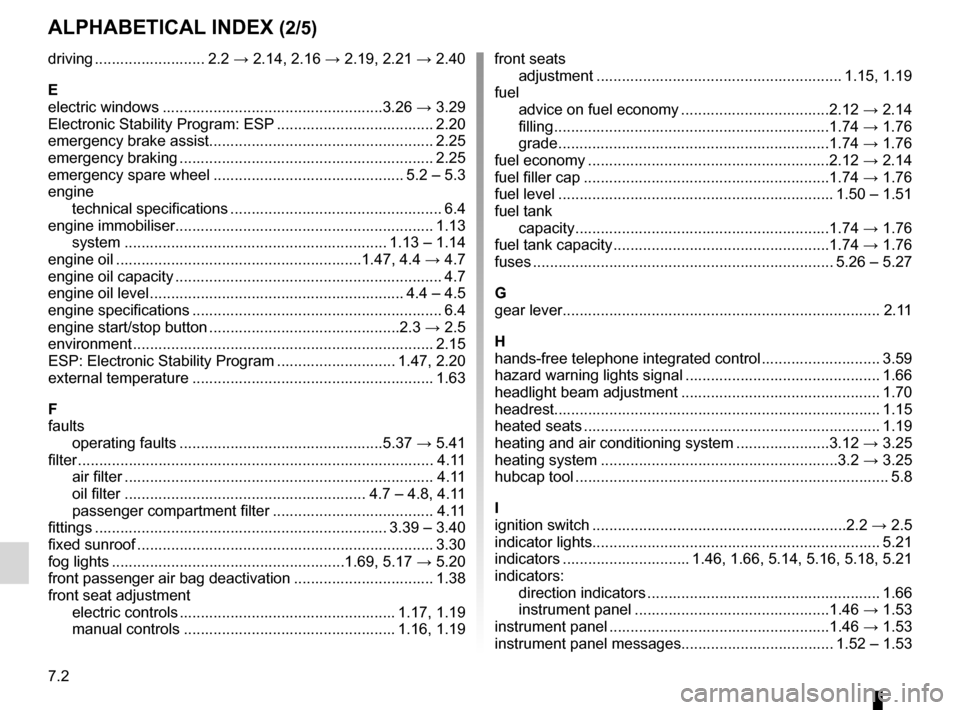
7.2
FRA_UD25606_4
Index (X81 - J81 - Renault)
ENG_NU_932-3_X81ph3_Renault_7
Jaune NoirNoir texte
AlphAbeticAl index (2/5)
driving .......................... 2.2 → 2.14, 2.16 → 2.19, 2.21 → 2.40
e
electric windows .................................................... 3.26 → 3.29
Electronic Stability Program: ESP ..................................... 2.20
emergency brake assist ..................................................... 2.25
emergency braking ............................................................ 2.25
emergency spare wheel ............................................. 5.2 – 5.3
engine technical specifications .................................................. 6.4
engine immobiliser............................................................. 1.13
system .............................................................. 1.13 – 1.14
engine oil .......................................................... 1.47, 4.4 → 4.7
engine oil capacity ............................................................... 4.7
engine oil level ............................................................ 4.4 – 4.5
engine specifications ........................................................... 6.4
engine start/stop button ............................................. 2.3 → 2.5
environment ....................................................................... 2.15
ESP: Electronic Stability Program ............................ 1.47, 2.20
external temperature ......................................................... 1.63
F
faults operating faults ................................................ 5.37 → 5.41
filter ........................................................................\
............ 4.11
air filter ......................................................................... 4.11
oil filter ......................................................... 4.7 – 4.8, 4.11
passenger compartment filter ...................................... 4.11
fittings ..................................................................... 3.39 – 3.40
fixed sunroof ...................................................................... 3.30
fog lights ....................................................... 1.69, 5.17 → 5.20
front passenger air bag deactivation ................................. 1.38
front seat adjustment electric controls ................................................... 1.17, 1.19
manual controls .................................................. 1.16, 1.19front seats
adjustment .......................................................... 1.15, 1.19
fuel advice on fuel economy ................................... 2.12 → 2.14
filling ................................................................. 1.74 → 1.76
grade ................................................................ 1.74 → 1.76
fuel economy ......................................................... 2.12 → 2.14
fuel filler cap .......................................................... 1.74 → 1.76
fuel level ................................................................. 1.50 – 1.51
fuel tank capacity ............................................................ 1.74 → 1.76
fuel tank capacity ................................................... 1.74 → 1.76
fuses ....................................................................... 5.26 – 5.27
G
gear lever ........................................................................\
... 2.11
h
hands-free telephone integrated control ............................ 3.59
hazard warning lights signal .............................................. 1.66
headlight beam adjustment ............................................... 1.70
headrest ........................................................................\
..... 1.15
heated seats ...................................................................... 1.19
heating and air conditioning system ...................... 3.12 → 3.25
heating system ........................................................ 3.2 → 3.25
hubcap tool ........................................................................\
.. 5.8
i
ignition switch ............................................................ 2.2 → 2.5
indicator lights .................................................................... 5.21
indicators .............................. 1.46, 1.66, 5.14, 5.16, 5.18, 5.21
indicators: direction indicators ....................................................... 1.66
instrument panel .............................................. 1.46 → 1.53
instrument panel .................................................... 1.46 → 1.53
instrument panel messages ....................................1.52 – 1.53